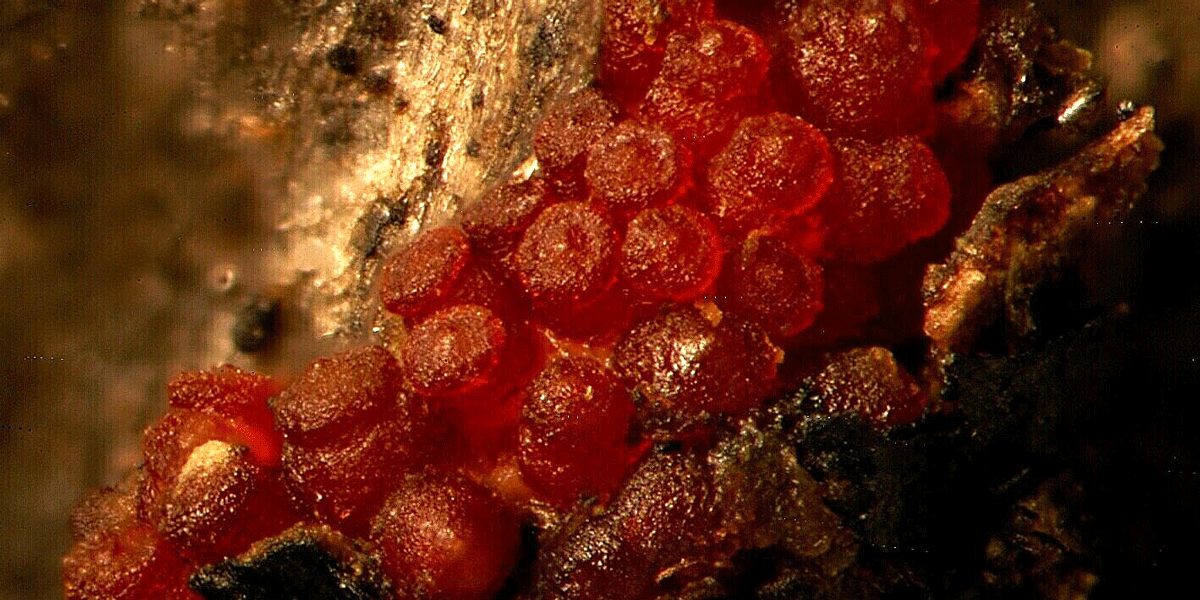Den ene ser ut som gelebringebærgodteri og den andre er så liten at det går flere av den på millimeteren. Sjekk ut Norges nyeste sopparter!
Stylonectria norvegica. Foto: Christian Lechat.
– Den har små, runde, oransje fruktlegemer og vokser på båndmose – Metzgeria furcata. Mosen er opp til en millimeter bred, og på den sitter soppen som små oransje kuler.
Slik beskriver soppforsker Björn Nordén den minste av de to nykomlingene, som nå har fått navnet Bryocentria hypothallina. Han innrømmer at det ikke er helt lett å oppdage en så liten sopp. Særlig vanskelig er det etter at soppen har dødd, for da forsvinner fargen slik at fruktlegemene blir helt gjennomsiktige. Størrelsen legger dog ingen demper på soppforskerens entusiasme.
– Jeg synes det er litt gøy at den er så liten – det går faktisk hele fem fruktlegemer på en millimeter. Den er med andre ord ingen matsopp, med mindre man finner veldig mange da.
 Bryocentria hypothallina vokser på båndmose. Foto: Jean-Paul Priou.
Bryocentria hypothallina vokser på båndmose. Foto: Jean-Paul Priou.
Nordén fant den lille soppen på et gammelt asketre i Strand kommune i Rogaland, mens han kartla gamle edelløvtrær i regi av Artsprosjektet til Artsdatabanken. Det faktum at Bryocentria hypothallina nettopp er oppdaget betyr imidlertid ikke at arten er sjelden.
– Mosen denne soppen vokser på er veldig vanlig, så da er det rimelig å anta at soppen også er ganske vanlig, sier Nordén.
Han legger til at soppen siden har blitt funnet både i Frankrike og Spania, noe som bekrefter tanken om at soppen nok ikke sjelden – selv om den har en unnselig framtoning.
Ser ut som bringebærgodteri
Den andre soppen ble oppdaget av den franske soppforskeren Christian Lechat under en workshop Björn Nordén arrangerte i Arendal, også den i regi av Artsprosjektet. Denne soppen har fått navnet Stylonectria norvegica, et navn som ikke avdekker soppens festlige framtoning.
– Den ser kort sagt ut som gelebringebærgodteri – det synes jeg er gøy.
Stylonectria norvegica ble funnet på kjernesopper, som igjen vokste på død ved av eik, bjørk og or. Også denne arten har seinere blitt funnet utenfor Norge.
 Björn Nordén synes Stylonectria norvegica ser ut som gelebringebærgodteri – er du enig? Foto: Christian Lechat.
Björn Nordén synes Stylonectria norvegica ser ut som gelebringebærgodteri – er du enig? Foto: Christian Lechat.
Vanskelig jobb å beskrive nye arter
Det er ikke så lenge siden Björn Nordén sist oppdaget en ny soppart – nemlig Chlorostroma vestlandicum, som ble funnet i almeskogen på Vestlandet. Han forklarer at det ikke er helt uvanlig for en soppforsker å finne nye arter.
– Realiteten er at det bare er en liten del av alle verdens sopper som er beskrevet, så det er veldig mange ukjente arter å ta av, forklarer Nordén.
Han legger til at det dessuten er mangel på soppforskere som er i stand til å identifisere nye arter, og som har den kunnskapen som skal til for å beskrive disse vitenskapelige.
– For å kunne beskrive en ny art vitenskapelig er det nødvendig at du kjenner til alle artene innen den slekten eller familien du jobber med, utdyper Nordén.
Han legger til at han i beskrivelsen av disse to soppene samarbeidet med både tyske og franske forskere som er eksperter på den soppslekten nykomlingene nå har blitt innlemmet i.
– Uten deres hjelp hadde det ikke blitt noen artsbeskrivelse.
Kontakt: Björn Nordén
Referanse:
Lechat, C., Fournier, J., Nordén B. (2015): Stylonectria norvegica (Nectriaceae), a new species from Norway. Ascomycete.org 7: 220-224.
Nordén B, Gardiennet, A, Priou, JP, Döbbeler, P (2015): Bryocentria hypothallina (Hypocreales) – a new species on Metzgeria furcata. Ascomycete.org 7: 121-124.